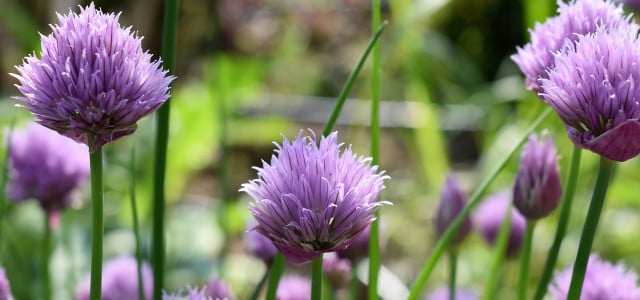Pink and purple chive flowers appear in late spring to early summer, depending on your region. Like chives themselves, you can use them as seasoning or decoration in the kitchen. We’ll show you how to harvest and use the edible chive blossoms.
Chive blossoms are not only pretty to look at, but they’re also good at attracting pollinators and they taste great. So to answer your question — yes you can eat chive blossoms. Unlike the aromatic spicy stalks of chives, the flowers have a somewhat milder and slightly sweeter taste, making them ideal for salads and sandwiches.
Like most edible flowers, chive blossoms contain many secondary plant compounds, vitamins, and minerals. The freshly harvested flowers and buds are a healthy source of nutrients, which you can use without hesitation in salads, soups, or other dishes. Chives and their flowers have long been used in traditional medicine as a way to stimulate the appetite and aid in digestion.
Harvesting Chive Flowers

While the chive plant will continue to grow all summer long, the flowers bloom from mid-May to late June, depending on where you live. Chive flowers contain a lot of nectar, making them a very bee-friendly plant that also attracts all kinds of other insects.
To avoid picking chive flowers full of bugs, harvest them in the early morning hours. Chive blossoms have a higher concentration of essential oils in the morning, and most insects don’t start to forage until the sun comes up.
How to Harvest Chive Flowers:
- Cut the flower stalks directly at the base with a sharp knife.
- Give the harvested chive blossoms a good shake to ensure any insects are removed.
- Try to collect blossoms that are clean and intact. Washing or rinsing the flowers destroys the petals and causes the blossoms to lose their aroma.
- To get the most flavor, harvest the chive flowers just before using them.
Tip: Once the chives bloom, the stalks start to lose their strong aroma because the plant puts all its energy into creating the flower. You can still use the chives afterward, just be careful to avoid woody stalks.
Aromatic Chive Blossom Butter Recipe



Chive blossoms can be used in many ways in the kitchen. You can sprinkle the flowers decoratively over salads or soups, or use them to garnish sandwiches or pasta dishes. Pickling the blooms in salt, oil or vinegar is also popular. If you’re a fan of herb butter, you can combine the mild flowers with the stalks to make chive blossom butter that’s perfect for summer.
Ingredients:
- 1 cup vegan butter or margarine
- 2 clove(s) of garlic
- 20 chive blossoms
- a few stalks of chives
- salt and pepper
Instructions:
- Put the butter or vegan margarine in a small saucepan and soften over low heat. Make sure that it does not liquefy completely.
- Peel and finely chop the garlic, then mix it with the softened butter.
- Ensure that your chive flowers are insect-free, then pluck off the individual petals.
- Wash the chives and finely chop them.
- Add the flowers and chives to the butter and mix thoroughly.
- Finally, season the butter with salt and pepper and refrigerate for a few hours before serving.
Do you like this post?







